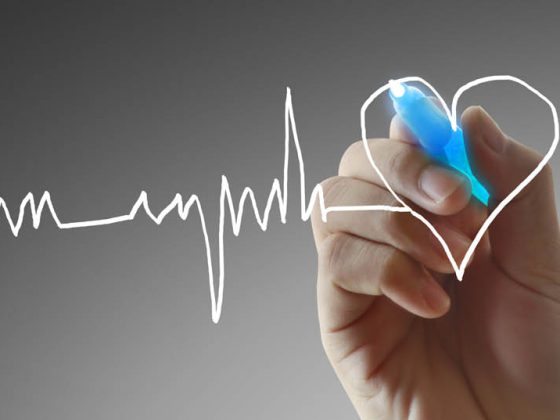In June 2015, the “25th European Meeting on Hypertension and Cardiovascular Protection” was held in Milan. In various oral sessions, the latest study results on subfields of hypertension research were presented – many results also with clinical relevance. We report hypertension screening and treatment in subpopulations: HIV-infected individuals, smokers, the very elderly, coffee drinkers, and children.
HIV-infected individuals are at increased risk for cardiovascular complications. A study was conducted to investigate the value of 24-hour ambulatory blood pressure monitoring (ABPM) in diagnosing hypertension in HIV-infected individuals [1].
Inadequate hypertension control common in HIV-infected patients
Data from the RECOVIH registry (registry of cardiovascular complications among people living with HIV) were analyzed, including 263 HIV patients who underwent ABPM at Hospital Saint Antoine, Paris. The patients, 91% of whom were men, were on average 50 years old and had been living with HIV infection for a median of 15 years. In 57%, hypertension was already known before ABPM. Hypertension was considered to be a blood pressure above 140/90 mmHg when measured in the clinic resp. Above 130/80 mmHg at ABPM.
In the RECOVIH registry, hypertension prevalence was 22%; of these, half were masked hypertension diagnosed only by ABPM. According to blood pressure measurement in the clinic, 45% of patients with known hypertension had inadequate control of their blood pressure; according to ABPM, this was the case in 32% of patients. In the patients with uncontrolled hypertension, the nocturnal blood pressure values were often too high.
The authors conclude that masked hypertension is common in HIV patients and that there is often inadequate blood pressure control in HIV patients with treated hypertension. Blood pressure measurement in the clinic alone is not sufficient to diagnose hypertension and achieve good blood pressure control. Therefore, ABPM should be routinely used in patients with HIV infection for diagnostic and follow-up purposes.
Worse blood pressure values in smokers
With antihypertensive monotherapy, only about half of all hypertensives achieve good blood pressure values. A study from Ireland examined the hypothesis that blood pressure control is even worse in smokers than in nonsmokers [2]. Approximately 300 patients receiving antihypertensive monotherapy for the first time were classified as nonsmokers (n=134), smokers (n=64), and ex-smokers (n=104). Blood pressure and heart rate were measured before the start of therapy and one month later. Smokers and ex-smokers showed a significantly smaller reduction in blood pressure than nonsmokers. In addition to smoking, baseline systolic blood pressure and female sex were predictors of antihypertensive treatment failure.
Thus, smoking is not only an important cardiovascular risk factor, but also has a negative impact on antihypertensive treatment – another reason to strongly recommend that patients stop smoking.
White coat hypertension is not harmless
What is the risk of white coat hypertension (WH) or masked hypertension (MH) developing into chronic hypertension (CH)? This question was investigated by researchers in Finland [3]. In all study participants, blood pressure (BP) was measured several times in the office and at home in 2000 and 2011. 582 subjects were normotensive (practice BP <140/90 mmHg, home BP <135/85 mmHg), 142 had WH (practice BP ≥140/90 mmHg, home BP <135/85 mmHg), and 63 had MH (practice BP <140/90 mmHg, home BP ≥135/85 mmHg). Evolution to CH (practice BP ≥140/90 mmHg, home BP ≥135/85 mmHg, or initiation of antihypertensive medication) was examined.
During the 11-year follow-up, 18% of normotensive subjects developed CH; this was 52% in subjects with WH and 73% in subjects with MH. Major cardiovascular events such as myocardial infarction, stroke, or hospitalization for heart failure occurred in 2.4% of normotensive subjects, in 10.4% of subjects with WH, and in 16.4% of subjects with MH.
The results show that neither white coat hypertension nor masked hypertension are harmless phenomena. Affected individuals are at greatly increased risk for chronic hypertension and cardiovascular events and should be counseled and followed up accordingly.
Orthostatic hypertension in the elderly prognostically unfavorable
The prevalence and prognostic significance of orthostatic hypertension (OHr) in the very elderly is not yet known. A French study investigated the association between OHr and cardiovascular morbidity and mortality in nursing home patients [4]. The study, which had a follow-up of two years, enrolled 972 subjects (223 of whom were men) with an average age of 88 years. Medical history was obtained, including in particular past falls, cardiovascular events, and medication, and functional status, cognitive function, blood pressure, and aortic stiffness were assessed. Blood pressure measurements were taken one and three minutes after standing up. OHr was defined as an increase in systolic blood pressure >20 mmHg during the first three minutes after standing up, orthostatic hypotension (OHo) as a decrease in systolic blood pressure >20 mmHg resp. of diastolic blood pressure >10 mmHg. 540 study participants had orthostatic normotension, 157 had OHo, and 275 had OHr. Those with OHr were at increased risk for cardiovascular morbidity and mortality (eg, stroke, myocardial infarction, heart failure, etc., HR 1.53 [KI 1,12–2,08]) compared with normotensive subjects. Risk was also increased in those with OHo (HR 1.40 [KI 0,96–2,05]). Normotensive subjects survived longer on average than subjects from the other two groups.
Hypertension and coffee: an unpleasant combination
Whether or not coffee drinking is dangerous for hypertensives remains controversial. In the present study, the association between coffee consumption and cardiovascular events was investigated [5]. They analyzed data from 1200 people who had participated in the HARVEST study; they were between 18 and 45 years old, had mild hypertension but no diabetes. 26.3% of study participants drank no coffee, 62.7% drank one to three cups per day (moderate coffee drinkers), and 10% drank more than three cups daily (heavy coffee drinkers).
During the follow-up of 12.5 years, 60 cardiovascular events occurred. Coffee consumption was significantly associated with the development of hypertension requiring treatment (HR 1.5 [KI 1,1–1,9] for heavy coffee drinkers, HR 1.1 [KI 0,9–1,3] for moderate drinkers). In addition, there was an association between coffee consumption and the development of prediabetes (HR 2.0 for heavy coffee drinkers, HR 1.3 for moderate coffee drinkers). After excluding all other risk factors, regular coffee drinking was also shown to be an independent risk factor for cardiovascular events (HR 4.3 for heavy coffee drinkers, 2.9 for moderate coffee drinkers).
The authors conclude from these results that in individuals with mild hypertension, the level of coffee consumption is linearly associated with an increased risk of cardiovascular events. Younger individuals with hypertension should therefore reduce their coffee consumption.
Which children to screen for hypertension?
Is it appropriate to screen all children for hypertension? A study from Lausanne addressed this question. Data from approximately 5200 children aged 10-14 years from the canton of Vaud were analyzed [6]. The researchers paid particular attention to the factors of overweight and the presence of hypertension in the parents. The children’s blood pressure was measured three times at intervals of one week each; hypertension was present if a child had blood pressure values that were too high three times.
The prevalence of hypertension was 2.2%. 14% of all children were overweight, and 20% had a positive history of hypertension in one or both parents. One or even both risk factors were present in 30% of the children. Hypertension in parents (OR: 2.6; 95% CI 1.8-4.0), overweight without obesity (OR: 2.5; 95% CI 1.5-4.2), and obesity (OR: 10.1; 95% CI 6.0-17.0) were associated with hypertension in children. The predictive value of risk factors alone was relatively low.
The authors concluded that limiting hypertension screening to children with overweight/obesity resp. with hypertensive parents would reduce the proportion of children to be screened to 30% and allow a relatively high proportion of 65% of hypertensive children to be screened. This would be a valid alternative to general screening.
Source:25th European Meeting on Hypertension and Cardiovascular Protection, June 12-15, 2015, Milan.
Literature:
- Nuernberg M, et al: Usefulness of 24-hour-ambulatory blood pressure monitoring in people living with HIV. J of Hypertension 2015; 33 (eSupplement 1): Abs 1B.08.
- Mahmud A, et al: Cigarette smoking reduces blood pressure response to antihypertensive treatment in newly diagnosed hypertensive patients. J of Hypertension 2015; 33 (eSupplement 1): Abs 7B.07.
- Sivén S, et al: Whitecoat and masked hypertension as risk factors for progression to sustained hypertension: the finnhome study. J of Hypertension 2015; 33 (eSupplement 1): Abs 1B.03.
- Agnoletti D, et al: Evidence for a prognostic role of orthostatic hypertension on survival in a very old institutionalized population. J of Hypertension 2015; 33 (eSupplement 1): Abs 1C.02.
- Mos C, et al: Coffee consumption is a predictor of cardiovascular events in young and middle aged hypertensive subjects. J of Hypertension 2015; 33 (eSupplement 1): Para 1C.04.
- Bloetzer C, et al: Performance of targeted screening for the identification of hypertension in children. J of Hypertension 2015; 33 (eSupplement 1): Abs 3B.01.
CARDIOVASC 2015; 14(5): 26-29











